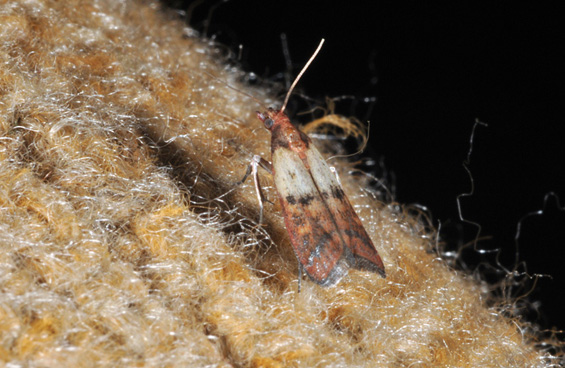
Common Name: Indian meal moth
Scientific Name: Pyralidae: Plodia interpunctella
Status: A pest of stored food products
Damaging Stage: Caterpillar
Biology: Adults are small (3/8-inch long) with a wingspan of about 5/8 inch. The overall body color is generally brown-gray, but the tip half of the wing is rust or bronze colored. Larvae have brown head capsule and are a dirty white or cream color. Sometimes, they may have a slight pink, green or yellow tint. They are approximately 2/3 inches long.
Female moths lay their eggs singly or in clusters on suitable larval food. The larvae hatch from the eggs and produce silken tunnels for protection while feeding. Larval development time varies with temperature and type of food material. Before pupating, the larvae leave the food source. There are four to six generations per year.
Injury: Larval feeding is usually restricted to the top one or two inches in grain stores. Smaller larvae feed on finer materials within the grain and larger larvae feed on the grain germ itself. As the larvae mature, they leave behind silken threads that bind to food particles. This webbing is often what attracts attention.
Action Threshold: In stored grains, larvae must enter through a hole or at the seam. However, newly-hatched larvae can pass through mesh screens. Meal moth feeding reduces dry weight and diminishes the value of the product. In homes, any food products that are loosely sealed or in thin wrapping that have remained in a cupboard for long periods is more likely to be infested. Food products that are infested should be immediately discarded.
Management: Good sanitation practices are the best way to control Indian meal moth populations. This involves removing old grain and thoroughly cleaning all grain bins before new grain is stored. Chemical controls are a possibility but should only be used in a case of extreme infestation.
|